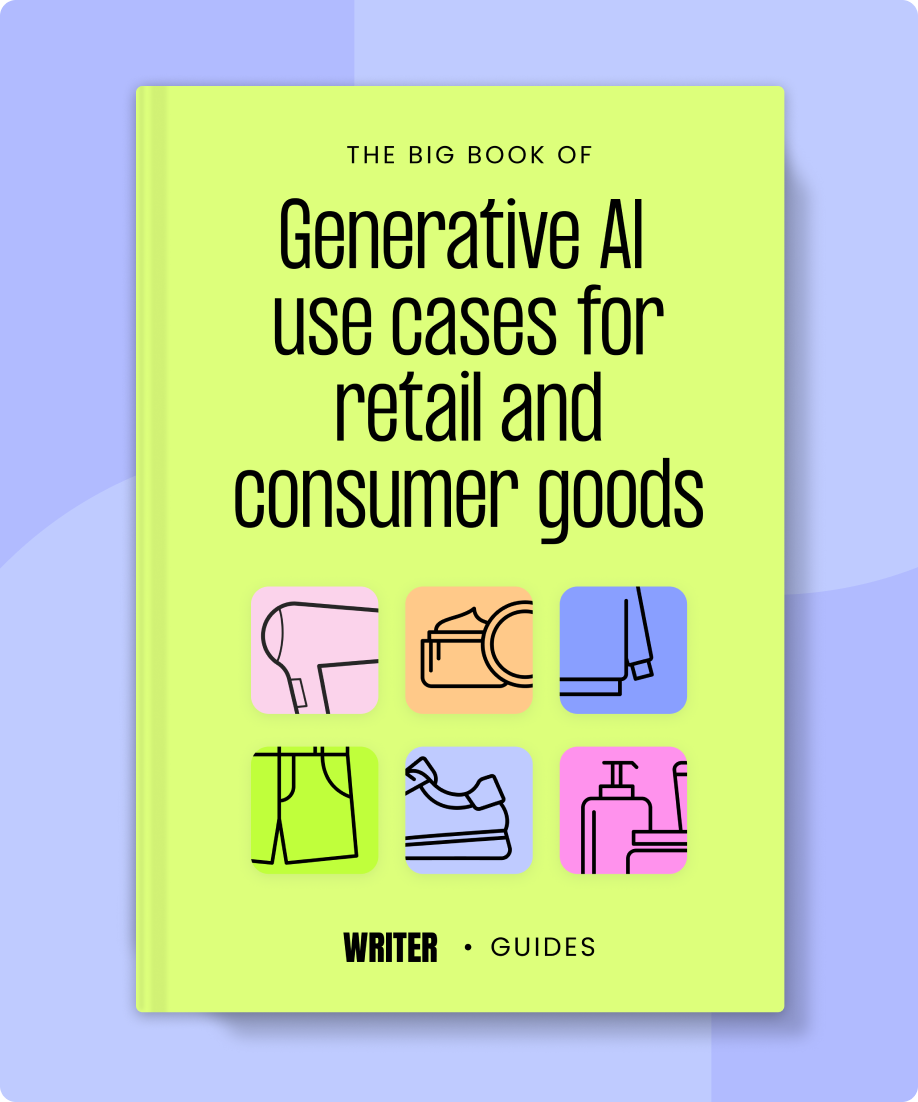Generative AI
use cases for
retail and
consumer goods

Introduction
Ever tried to shop for a specific item in a sprawling department store without knowing how to navigate the different sections? You might have all the products at your fingertips, but you need the right guidance to save time and not leave empty-handed.
Trying to navigate the world of AI without a guide is similar. By now, we’re either all familiar with generative AI or are using it in our personal or work lives. But as a business leader, thinking broader and having a vision for organization-wide transformation is important.

Download the ebook
Accelerating speed to market in retail and consumer goods with generative AI for mission-critical workflows
Leading retailers and brands are already using generative AI across their mission-critical workflows to achieve faster speed to market for new products, experiences, and campaigns. Don’t miss out on the opportunity to stay competitive and drive innovation in your own core business operations. Embracing generative AI can help you stay ahead of the curve, grow the business, and drive efficiencies across the entire product lifecycle — from SKU to store.
“The purpose of generative AI isn’t intended to replace human talent but to augment and assist it. On average, 46% of working hours in retail across frontline and corporate roles could be enabled by this technology. Generative AI has internal and external applications spanning Strategy, Data & Analytics, Merchandising, Product Development, Supply Chain, Stores, Finance, and HR.”
How to get the most out of this guide
We organized this guide into modules by function, highlighting generative AI use cases for mission-critical workflows. From R&D in consumer goods to merchandising and store operations in retail — to marketing and customer support in both — we’ve got you covered with practical applications tailored to your industry.
We’ll also look at how one real-life retailer, Adore Me, uses the WRITER generative AI platform to create hundreds of product descriptions every month, follow environmental, social, and governance (ESG) guidelines, and free up resources to allow employees to work more strategically. And we’ll take a look at how one global consumer brand freed up 2,000 hours and $500K in agency spend by centralizing the content production process — generating and translating PDPs and blog posts, and delivering on-brand content that’s optimized for SEO — ultimately freeing up teams to bring a new level of creativity and efficiency to their daily operations.
Get started with these generative AI use cases in retail and consumer goods
Research and development (R&D)
In consumer brands, R&D teams aim to protect the business and drive product innovation. But, divisional silos and an inefficient discovery process often lead to wasted resources on duplicate research. Generative AI can help fix this by breaking down those silos and giving every product team quick access to existing insights and research, making the R&D process more efficient.
Customer insights knowledge assistant
Customer insights come in from different places, such as social media, online or app store reviews, customer interviews, and support calls. For R&D and product teams, sifting through this vast amount of data to identify trends can be a daunting task. With generative AI, brands can put the power of all this data in every team member’s hands — from R&D to product to design — using a customer insights knowledge assistant. What did a specific audience say about style versus comfort? Did customers prefer sheen or matte? Whatever the question is, a simple chat interface can allow teams to instantly analyze hundreds of thousands of customer feedback to instantly derive valuable insights that can inform new products and improve the customer experience.
Defect discovery and resolution
Traditionally, addressing defects like product issues can take weeks to months. But with the aid of generative AI, R&D teams can automate the creation of detailed discovery documents. These documents outline potential reasons for defects, proposed solutions, and supporting evidence, ultimately accelerating product improvements that improve customer satisfaction.
“In the consumer goods sector, generative AI could automate or augment 40–60% of activities.”
Merchandising
In the retail industry, generative AI provides instant insights and data-driven recommendations for merchandising, which inform product offerings and promotions aligned with customer preferences and market trends.
Competitive product insights
Merchandising teams can use generative AI to make sure the right products are always in stock by analyzing customer feedback and competitor data. For example, a retail business can use generative AI to collate and tag competing stores’ products to detect early signs that competitors are carrying a new line of products, responding to a surge in market interest. This allows them to quickly jump in before missing out on the hype.
Using generative AI to monitor competitor pricing and offerings, retailers can differentiate their offerings and stay competitive. Analyzing customer behavior and trends to identify new, popular, and declining product categories helps companies make strategic merchandising decisions. This, in turn, improves inventory management — preventing overstocking and stockouts.
Store operations
For retailers with physical stores, store operations are critical for maintaining positive customer relations and driving sales. This means equipping new store associates with the right knowledge or enabling all associates with answers to customer questions at their fingertips.
Store associate onboarding
Store associates must be well-prepared to handle the demands of the retail environment. Using generative AI, retail businesses can create and update standard operating procedures tailored to the store’s specific needs. This can cover everything from how to handle returns or exchanges to season-specific policies for events like Black Friday. Generative AI can also assist with training by simulating customer service scenarios — allowing new hires to practice and receive immediate feedback.
In-store associate enablement
Too many shoppers and not enough associates with the answers to all those questions? An in-store associate knowledge assistant powered by a custom chatbot can ensure every store associate has all the right answers. Connect a custom chatbot to your company’s wiki and training materials so it pulls answers directly from your sources of truth.
Then, store associates can quickly and accurately answer customer questions about specific topics like store policies, product features, product availability, and promotions. These helpful replies will impress shoppers, and you can rest easy knowing that consistent and correct information is always provided — especially during busy periods.
Marketing
A retail and consumer marketing team has to manage many conflicting elements at once. Generative AI lessens the burden on marketers by helping them quickly apply valuable customer data and tailor content and campaigns at scale. That’s more high-quality outputs, faster review cycles, and less rework.
Personalized PDP workflows
The PDP experience is essential for converting traffic into sales. Marketers can use generative AI to improve PDP creation and optimization, increasing organic traffic with SEO enhancements, ensuring accurate product descriptions, and thereby reducing returns. They can also, if applicable, tailor multiple versions to meet different retailer requirements. With generative AI, marketers can produce and optimize personalized PDP content at scale, improving conversion rates while ensuring brand consistency.
Unique campaign assets and test variants
Marketers must increasingly craft personalized campaigns, content, and messages to capture and retain shoppers. With generative AI, marketers are rapidly identifying key sentiments and trends, ideating campaign themes, writing creative briefs and messaging documents, and generating a variety of assets — from unique landing pages to outbound engagement across social media, email, and video — all tailored to support multiple audience segments or to help refresh existing content for new marketing campaigns.
Savvy, data-driven marketing teams today use generative AI to generate copy at scale for every campaign, channel, format, and audience. They even have dozens of test variants for an email subject line to maximize conversion and revenue.
Marketing content translation and transcreation
As a retailer or consumer brand, your message needs to resonate across different markets. Whether you need to translate ad content, blog posts, product brochures, product installation documents, or warranty information, generative AI can help you do it all faster and at scale. Use generative AI to convert marketing material into dozens of languages and even dialects — or tailor materials for unique regional and cultural differences, ensuring efficiency, accuracy, compliance, and relevance.
“Retailers are using generative AI to streamline content creation and tailor messaging for different customer segments while leveraging data for insights and cutting creative development costs.”
Customer support
Customers and support agents alike can get frustrated with high call volumes, long waits, and call escalations. Generative AI can make life easier for customer service teams while allowing them to meet customer expectations more efficiently and accurately.
Customer support agent knowledge assistant
Enable customer support agents with a knowledge assistant that helps them answer any question, resulting in customer interactions that are more personalized, engaging, and helpful. A knowledge assistant connected to all your product or store information and the latest commonly asked questions can help agents quickly answer any question they’re stuck on. A simple chat interface makes it easy for agents to use generative AI in their day-to-day workflows. Call times go down, customer satisfaction increases, and the workload on human agents reduces. Generative AI in the call center is a great place to start for quick ROI.
Knowledge or help articles
Does your company have an enormous body of content in your knowledge or help center that needs continuous development and maintenance? Think about help articles, frequently asked questions, return policies, and product tutorials. Your team may even have to translate and localize those resources to different markets — a costly and time-consuming process that negatively impacts your speed to market. With generative AI, customer support teams can collate the top questions from customers, efficiently turn those into help articles, check against brand, legal, or regulatory requirements, and translate those across multiple languages — all in an instant with a generative AI workflow.
“Retailers are exploring solutions to augment contact center representatives with generative AI to improve access to data, provide real-time coaching, and streamline post-call activities.”
Evaluating generative AI solutions for your business
With the right generative AI tools in place, all of these business-transforming use cases are possible. Here are the capabilities your generative AI platform should have:
- Ability to create custom AI applications based on your business logic
- Deliver fast, consistent, and reliable outputs
- Securely connect to your structured and unstructured data to generate outputs tailored to your business
- Speak in your voice and write in your style
- Help you meet legal, regulatory, and compliance needs
- Integrate easily into existing systems and workflows
- Protect everyone’s data (yours and your customers)
- Models that aren’t trained on your data
Case study
Retail
How Adore Me uses WRITER to speed up time to market from months to minutes

Adore Me is a digitally-native intimates brand that Victoria’s Secret & Co. acquired. They offer a wide range of lingerie and apparel for women of all sizes and budgets. Adore Me stands out for its innovative Home Try-On commerce service, which allows customers to try on products before purchasing. They’re also committed to sustainability and have become the first Certified B Corporation intimate apparel brand in the US.
Ranjan Roy, Adore Me’s SVP of Strategy, had a years-long interest in AI. In his search for the right AI tool, Roy found WRITER impressively well-tailored to “actually solving real business problems for us.”
Custom generative AI apps for mission-critical retail workflows
Adore Me has deployed dozens of custom AI apps through WRITER AI Studio that have helped them automate key processes and enjoy substantial time savings. One of their first use cases was to create an AI app to generate highly SEO-optimized product descriptions. Because they sell everything in sets, the phrase “bra and panty set” is crucial for search, even though it doesn’t sound natural. With the WRITER app, they enforced the use of this specific term, leading to a 40% increase in non-branded search volume.
Roy and his team also used WRITER to tackle the translation challenge when launching Adore Me Mexico. A small team — including a prompt coordinator, a merchandiser, and a native Mexican Spanish speaker — built an app using the WRITER no-code platform to refine translations. They added a prompt to enhance the output for Mexican consumers, focusing on the nuances of intimate apparel. This process, managed without a developer, allowed the team to efficiently translate and optimize 2,900 product descriptions, which were then uploaded to their website.
“Without AI Studio, it would’ve taken us months to launch Adore Me Mexico,” Roy says. “We’ve seen companies with repetitive content — like the 2,900 product descriptions — leave it in English and put the rest of the site in Spanish. What could’ve taken months took only 10 days.”
Sailing into a strategy-focused future
For Ranjan, the biggest benefit of using WRITER is that it allows his team to “automate the boring stuff,” allowing him and his team to work on more creative efforts. With all the time and effort saved, his team has been able to focus on the bigger creative picture.
What impressed him the most during Adore Me’s partnership with WRITER? “WRITER doesn’t follow trends that are happening in the industry, but actually creates products and infrastructure that lead the way.”
For more on Adore Me’s strategic deployment of generative AI, read the entire customer story.
Case study
CPG
How a CPG company uses WRITER to scale international markets and save 2,000 hours
A leading global CPG brand sought to reinvent its content creation and management processes using generative AI. They felt discouraged by the slow, expensive process of working with external agencies. They saw AI as the key to speeding up their time to market, creating more personalized shopping experiences, and staying on top of the latest industry trends.
To make this happen, they needed a partner who could tailor AI to their needs, maintain brand compliance, and meet all the enterprise standards. WRITER stood out for its custom AI apps, strict brand adherence, multilingual support, and smooth implementation and scaling.
Before WRITER: Costly, decentralized content creation
Managing content and operations across 25+ global teams is no easy task. Before finding WRITER, the CPG company faced a labor-intensive and costly content creation process. Each region managed content independently, leading to lengthy approval cycles, duplicate efforts, and inconsistent brand messaging.
The reliance on external agencies for drafting PDPs, campaign materials, and regular content updates resulted in significant bottlenecks and missed opportunities to capitalize on trending topics. These challenges not only increased operational costs but also hindered the company’s ability to maintain SEO efficacy and respond quickly to consumer demands.
Scalable solutions that inject creativity and efficiency back into daily operations
WRITER helped the CPG company reinvent its content creation process. Centralizing foundational product content was just the beginning. They developed custom AI apps to instantly generate and translate PDPs and blog posts into all the required regional languages. Now, they have over 75 live AI apps, and the first app was shipped in three months.
This move not only eliminated the need for external translation agencies but also improved their workflow efficiency by integrating WRITER’s APIs with Salsify and Microsoft. What used to take weeks now happens in seconds, delivering high-quality, on-brand materials optimized for SEO.
Global teams, once bogged down by the tedious task of creating basic content, are now free to focus on more strategic and engaging activities, like covering local trends and interests. For example, the team was able to capitalize on a trending search term, promptly updating their content. They saw a 165% increase in impressions and an eight-position rise in SEO rankings.
This shift not only freed up around 2,000 hours and saved over $500,000 per year in agency costs but also injected a new level of creativity and efficiency into their daily operations.
Discover how WRITER checks all the boxes for retail and consumer goods companies
1 Reinventing the consumer goods value chain by Oliver Wright, senior managing director – global consumer industries group lead, Accenture, et. al.
2 Generative AI in Retail: How to Reinvent Now to Build for the Future by Brooks Kitchel, Senior Managing Director – Global Retail Strategy Lead, Accenture
